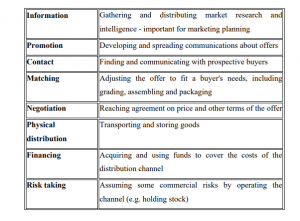Distribution describes all the logistics involved in delivering a company’s products or services to the right place, at the right time, for the lowest cost. Well-chosen channels constitute a significant competitive advantage, while poorly conceived or chosen channels can doom even a superior product or service to failure in the market. Distribution (or “Place”) is the fourth traditional element of the marketing mix. The other three are Product, Price and Promotion.
The Nature of Distribution Channels
Most businesses use third parties or intermediaries to bring their products to market. They try to forge a “distribution channel” which can be defined as “All the organizations through which a product must pass between its point of production and consumption” Why does a business give the job of selling its products to intermediaries? After all, using intermediaries means giving up some control over how products are sold and who they are sold to.
The answer lies in efficiency of distribution costs. Intermediaries are specialists in selling. They have the contacts, experience and scale of operation which means that greater sales can be achieved than if the producing business tried run a sales operation itself.
Functions of a Distribution Channel
The main function of a distribution channel is to provide a link between production and consumption. Organizations that form any particular distribution channel perform many key functions:

All of the above functions need to be undertaken in any market. The question is – who performs them and how many levels there need to be in the distribution channel in order to make it cost effective.
Numbers of Distribution Channel Levels
Each layer of marketing intermediaries that performs some work in bringing the product to its final buyer is a “channel level”. The figure below shows some examples of channel levels for consumer marketing channels:

In the figure above, Channel 1 is called a “direct-marketing” channel, since it has no intermediary levels. In this case the manufacturer sells directly to customers. An example of a direct marketing channel would be a factory outlet store. Many holiday companies also market direct to consumers, bypassing a traditional retail intermediary – the travel agent. The remaining channels are “indirect-marketing channels”.
Channel 2 contains one intermediary. In consumer markets, this is typically a retailer. The consumer electrical goods market in Kenya is typical of this arrangement whereby producers such as Sony, Panasonic, Canon etc. sell their goods directly to large retailers
such as Nakumatt and Tuskys which then sell the goods to the final consumers. Channel 3 contains two intermediary levels – a wholesaler and a retailer. A wholesaler typically buys and stores large quantities of several producers’ goods and then breaks into
the bulk deliveries to supply retailers with smaller quantities. For small retailers with limited order quantities, the use of wholesalers makes economic sense. This arrangement tends to work best where the retail channel is fragmented – i.e. not dominated by a small
number of large, powerful retailers who have an incentive to cut out the wholesaler. A good example of this channel arrangement in the UK is the distribution of drugs.
Stockists
A dealer who undertakes to maintain stocks of a specified product at or above a certain minimum in return for favourable buying terms granted by the manufacturer of the product
Manufacturer’s representatives
Manufacturer’s representative or rep, manufacturer’s broker and manufacturer’s agent are all terms used to describe independent sales agents who work on commission. You don’t pay them a salary, just a percentage of what they sell. Manufacturer’s reps offer a
practical, cost-effective alternative to a direct sales force for many growing companies.
Warehousing
Performance of administrative and physical functions associated with storage of goods and materials. These functions include receipt, identification, inspection, verification, storage, retrieval for issue, etc.
Physical distribution
Physical distribution is the set of activities concerned with efficient movement of finished goods from the end of the production operation to the consumer. Physical distribution takes place within numerous wholesaling and retailing distribution channels, and includes such important decision areas as customer service, inventory control, materials handling, protective packaging, order procession, transportation, warehouse site selection, and warehousing. Physical distribution is part of a larger process called “distribution,” which includes wholesale and retail marketing, as well the physical movement of products.
Clearing and forwarding
Clearing and forwarding agents are service providers that can assist the importer/exporter to arrange transport, documentation and custom clearance for international shipments. Unless an exporting/importing company handles a vast amount of transactions per month, it is much more viable for them to make use of this service.